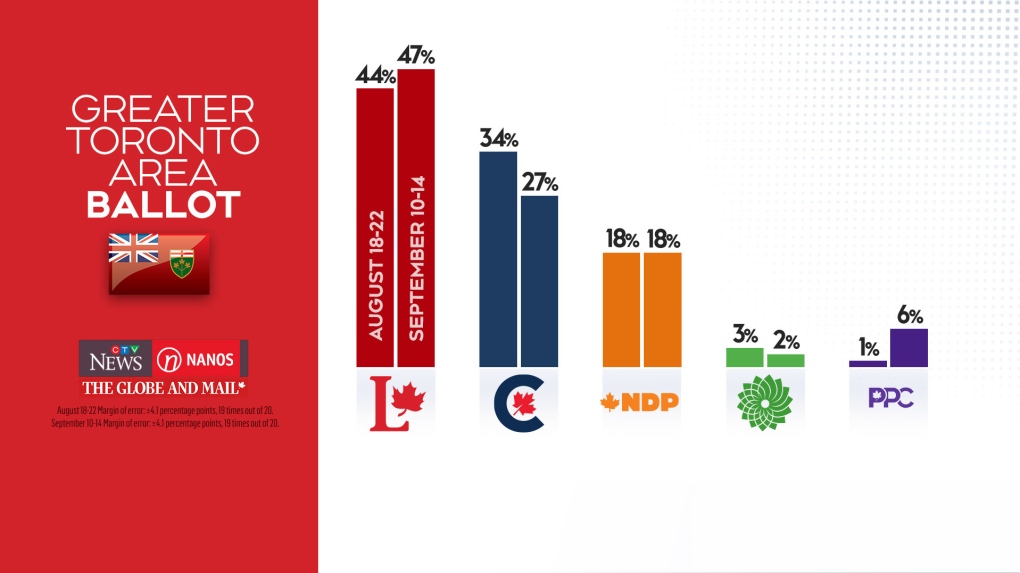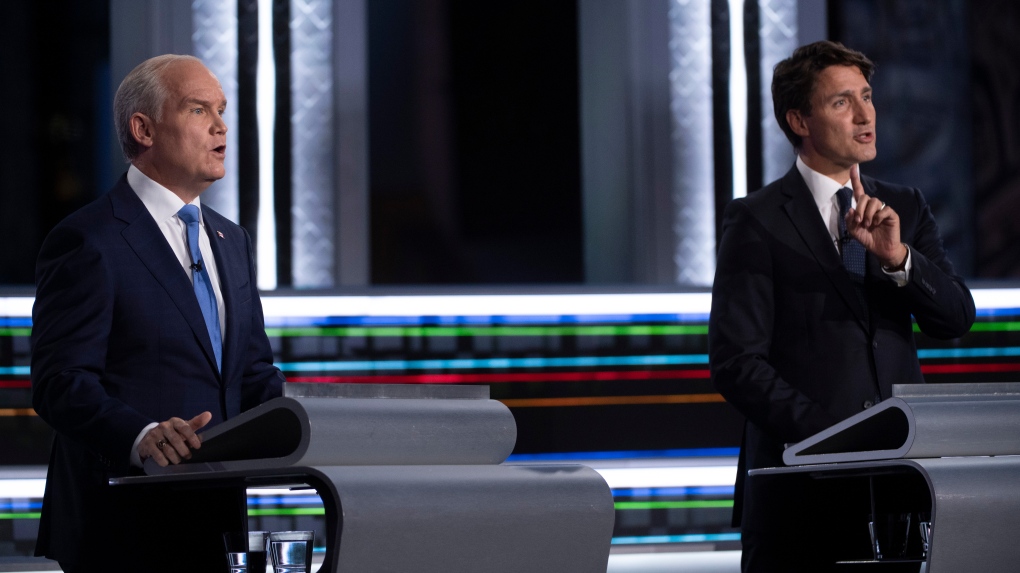Liberal lead widens in GTA as Nanos poll shows housing continues to be top ballot box issue
The rising cost of housing continues to outpace the COVID-19 pandemic as the top issue for GTA voters with less than five days left in the federal election campaign, a new poll suggests.
Nanos Research surveyed 500 adult residents on their top issues ahead of the Sept. 20 federal election, as well as the factors that are most likely to shape their vote.
About 32 per cent of respondents said, unprompted, that affordable housing is the single biggest issue facing the GTA, while 17.6 per cent said that it is the COVID-19 pandemic, and 14.4 per cent said that it is transit. Other issues of note included pollution (6.8 per cent), the cost of living overall (6.3 per cent), the economic recovery (six per cent) and healthcare (3.9 per cent).
"The thing is that, especially in the GTA, folks are worried about the cost of rent. They're worried about the housing supply. They're worried about the cost to pay their mortgage," pollster Nik Nanos told CP24 Wednesday night.
"It speaks to the level of anxiety that's out there for many individuals that live in the GTA on the housing front."
 A home for sale sign is shown in a Toronto west end neighbourhood May 8, 2020. (THE CANADIAN PRESS / Graeme Roy)
A home for sale sign is shown in a Toronto west end neighbourhood May 8, 2020. (THE CANADIAN PRESS / Graeme Roy)
The results are largely the same when compared to a similar survey conducted three weeks ago, though there was a four-point increase in the number of people identifying COVID-19 as the biggest issue in the GTA and an eight-point drop in the number of people who instead said affordable housing.
Toronto residents were slightly more likely to identify affordable housing as the top issue when compared to those in the 905 (34.5 per cent versus 30.1 per cent), while residents in the 905 were more likely to offer up the COVID-19 pandemic as the top issue instead (21.7 per cent versus 13 per cent).
Nanos described it as a 'meat and potatoes' election.
"They want to hear about practical things like housing. They want to hear about the pandemic response, transit, all that kind of stuff," he said.
"People want action, and they want to hear from parties about their strategy for housing, which is why all of the big federal parties are falling over themselves with strategies to try to help Canadians with having housing that can be affordable, whether it's renting or owning."
The pollsters also asked about what other factors will inform the decision that the prospective voters make at the polls.
About 85 per cent of respondents identified “a party’s plan for the future” as an important factor and about 50 per cent said that the performance of the leaders during the campaign was important. Only 34 per cent of respondents said that the performance of the leaders during the televised debates was important.
"It just speaks to the debate being entertaining, perhaps interesting, but not critical to forming a decision in terms of who Canadians would like to see as the next government," Nanos said.
"I think the format kind of undermined the impact of the debate in potentially shaping the outcome of the election."
 Bloc Quebecois Leader Yves-Francois Blanchet, left to right, Green Party Leader Annamie Paul, Liberal Leader Justin Trudeau, NDP Leader Jagmeet Singh, and Conservative Leader Erin O'Toole takes part in the federal election English-language Leaders debate in Gatineau, Que., on Thursday, Sept. 9, 2021. THE CANADIAN PRESS/Justin Tang
Bloc Quebecois Leader Yves-Francois Blanchet, left to right, Green Party Leader Annamie Paul, Liberal Leader Justin Trudeau, NDP Leader Jagmeet Singh, and Conservative Leader Erin O'Toole takes part in the federal election English-language Leaders debate in Gatineau, Que., on Thursday, Sept. 9, 2021. THE CANADIAN PRESS/Justin Tang
Its release comes hours after the publication of another Nanos Research survey showing that the Liberal Party appears to have increased its lead in the vote-rich GTA.
Polling conducted over five days between Aug. 18 - 22 showed that 44 per cent of respondents in the GTA ranked the Liberals as their first choice if the election were held today, followed by the Conservatives at 34 per cent, the NDP at 18 per cent, the Green Party at three per cent and the People's Party of Canada at one per cent.
Polling conducted over a new five-day period from Sept. 10-14 shows that the Liberals have now pulled several points ahead to 47 per cent support, while the Conservatives have dropped to 27 per cent support. That means that the Liberal Party has doubled its lead over the Conservatives in the Greater Toronto Area to 20 points since mid-August. Support for the NDP is unchanged at 18 per cent.
Interestingly, Conservative support appears to have been syphoned off to the right-wing People's Party of Canada, which has gained five points since August and now sits at six per cent support in the GTA.
Support for the Green Party has slipped down one point to two per cent.

“The Greater Toronto Area remains a Liberal stronghold. However, outside of (the) GTA, it is a horse race between the Conservatives and the Liberals,” Nanos said in a statement released with the poll. “People’s Party has improved fortunes since the beginning of the campaign.”
The trend in the GTA differs just slightly from polling across Ontario. Provincially, the Liberals have dropped two points and sit at 40 per cent support while the Conservatives have dropped five points and now sit at 30 per cent support. However the NDP has gained two points across the province to sit at 20 per cent support while the People's Party has gained six points and now sits at seven per cent provincially.
 Conservative leader Erin O'Toole and Liberal leader Justin Trudeau speak during the federal election French-language leaders debate, Wednesday, September 8, 2021 in Gatineau, Que. THE CANADIAN PRESS/Justin Tang
Conservative leader Erin O'Toole and Liberal leader Justin Trudeau speak during the federal election French-language leaders debate, Wednesday, September 8, 2021 in Gatineau, Que. THE CANADIAN PRESS/Justin Tang
Meanwhile, the latest nightly tracking numbers conducted by Nanos for CTV News and The Globe and Mail show that the Liberals and Conservatives are locked in a dead heat across the country, with the Conservatives currently at 31.2 per cent nationally and the Liberals at 30.5 per cent. The NDP sit at 21.4 per cent, while the Bloc Quebecois and the People’s Party each have around six per cent and the Greens sit at 3.7 per cent.
NANOS METHODOLOGY
The Nanos Research polling was conducted between Sept. 11 and 13th and is considered accurate to within 4.3 percentage points, 19 times out of 20. It is based on 1,200 random phone interviews conducted with eligible voters over a rolling three-day period. The margin of error is plus or minus 2.8 percentage points, 19 times out of 20.
The GTA polling surveyed 254 respondents in August and 261 in September through random telephone interviews. The province-wide data was compiled using responses from 560 Ontario voters in August and 588 in September. The margin of error for a survey of 560 or 588 respondents is plus or minus 4.1 percentage points, 19 times out of 20.
Voters are set to go to the polls across Canada on Monday, Sept. 20.
CTVNews.ca Top Stories

opinion Tom Mulcair: Prime Minister Justin Trudeau's train wreck of a final act
In his latest column for CTVNews.ca, former NDP leader and political analyst Tom Mulcair puts a spotlight on the 'spectacular failure' of Prime Minister Justin Trudeau's final act on the political stage.
B.C. mayor gets calls from across Canada about 'crazy' plan to recruit doctors
A British Columbia community's "out-of-the-box" plan to ease its family doctor shortage by hiring physicians as city employees is sparking interest from across Canada, says Colwood Mayor Doug Kobayashi.
'There’s no support': Domestic abuse survivor shares difficulties leaving her relationship
An Edmonton woman who tried to flee an abusive relationship ended up back where she started in part due to a lack of shelter space.
Baseball Hall of Famer Rickey Henderson dead at 65, reports say
Rickey Henderson, a Baseball Hall of Famer and Major League Baseball’s all-time stolen bases leader, is dead at 65, according to multiple reports.
Arizona third-grader saves choking friend
An Arizona third-grader is being recognized by his local fire department after saving a friend from choking.
Germans mourn the 5 killed and 200 injured in the apparent attack on a Christmas market
Germans on Saturday mourned the victims of an apparent attack in which authorities say a doctor drove into a busy outdoor Christmas market, killing five people, injuring 200 others and shaking the public’s sense of security at what would otherwise be a time of joy.
Blake Lively accuses 'It Ends With Us' director Justin Baldoni of harassment and smear campaign
Blake Lively has accused her 'It Ends With Us' director and co-star Justin Baldoni of sexual harassment on the set of the movie and a subsequent effort to “destroy' her reputation in a legal complaint.
Oysters distributed in B.C., Alberta, Ontario recalled for norovirus contamination
The Canadian Food Inspection Agency has issued a recall due to possible norovirus contamination of certain oysters distributed in British Columbia, Alberta and Ontario.
New rules clarify when travellers are compensated for flight disruptions
The federal government is proposing new rules surrounding airlines' obligations to travellers whose flights are disrupted, even when delays or cancellations are caused by an "exceptional circumstance" outside of carriers' control.


































